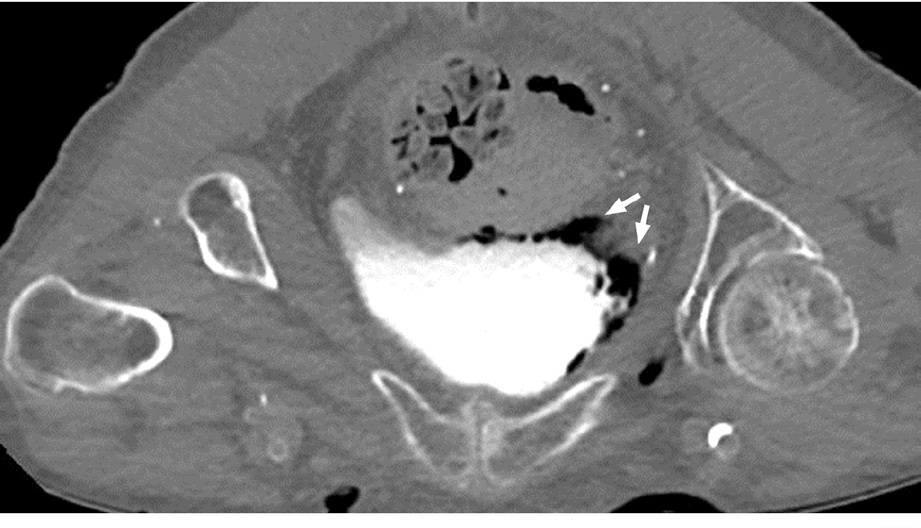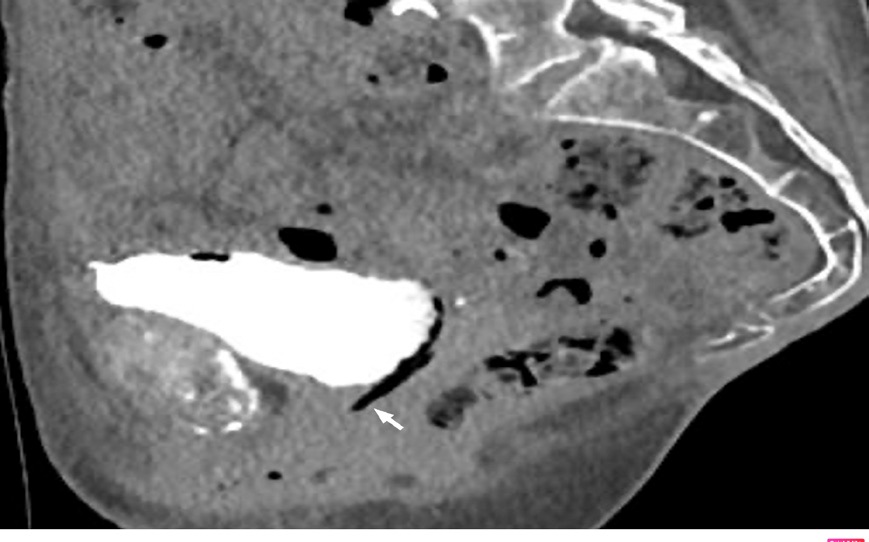
Journal of Clinical Images and Medical Case Reports
ISSN 2766-7820
Clinical Image - Open Access, Volume 3
Emphysematous cystitis in a renal transplant recipient
Emilie Devars1; Sylvain Guinebert1,2; Olivier Henon1,2; Sylvain Bodard1,2,3*
1 AP-HP, Hôpital Necker Enfants Malades, Service d’Imagerie Adulte, F-75015, Paris, France.
2 Université de Paris, F-75006, Paris, France.
3 Sorbonne Université, CNRS, INSERM Laboratoire d’Imagerie Biomédicale, Paris, France.
*Corresponding Author: Sylvain Bodard
Adult Department of Radiology, Necker Hospital,
149 Rue de Sèvres, 75015, Paris, France.
Email: Sylvain.bodard@aphp.fr
Received : Feb 01, 2022
Accepted : Feb 25, 2022
Published : Mar 04, 2022
Archived : www.jcimcr.org
Copyright : © Bodard S (2022).
Abstract
Emphysematous cystitis is a rare entity characterized by gas inside the bladder and in its wall on CT, the gold standard to establish the diagnosis. Few renal transplant recipients have reported few cases, and none of them had associated diabetes over the last ten years. We report the case of a 64-year-old female who had a history of type 2 diabetes mellitus and who presented emphysematous cystitis nine years after her kidney transplant for chronic interstitial nephropathy.
Abbreviations: CBEU: cytobacteriological examination of urine.; CT: Computed Tomography; CECT: Contrast-enhanced computed tomography; CBEU:Cytobacteriological examination of urine
Citation: Devars E, Guinebert S, Henon O, Bodard S. Emphysematous cystitis in a renal transplant recipient. J Clin Images Med Case Rep. 2022; 3(3): 1712.
Description
We report the case of a 64-year-old female who presented two episodes of low-grade hematuria nine years after her kidney transplant for chronic interstitial nephropathy. She had a history of type 2 diabetes mellitus, T-cell lymphoma, and several episodes of transplant Escherichia coli pyelonephritis. She was taking ciclosporin and prednisone as a medication. On examination, she had no fever, no pneumaturia or gross hematuria, no functional urinary signs, no abdominal or lumbar pain. Biology revealed acute renal failure (creatinine=105 μmol/L versus 43 μmol/L), C-Reactive Protein (CRP) level of 9 mg/dl, leuko-neutropenia, and non-regenerative normocytic anemia. Doppler Ultrasound of the renal graft did not reveal any urological or vascular complication. Abdominopelvic computed tomography (CT) revealed emphysematous cystitis responsible for bladder wall thickening with extensive intramural gas and no intraluminal gas accumulation (Figures 1 & 2), diffusing in the posterior wall of the urethra (Figure 3) and without any extravesical extension. The cytobacteriological examination of urine confirmed an E. coli infection without microhematuria. Treatment with Ceftriaxone 1g daily was started for 14 days, and a urinary catheter was inserted. A follow-up CT scan showed complete regression of the emphysema one week late
Emphysematous cystitis is a rare entity characterized by gas inside the bladder and in its wall on CT, the gold standard to establish the diagnosis [1]. Patients are most often women over 60 years [1]. Poorly controlled diabetes [1,3], immunosuppression, and urinary stasis [1] are well-known risk factors.
Few cases of emphysematous cystitis in renal transplant recipients have been reported [2], and none of them had associated diabetes over the last ten years. Treatment consists of antibiotic therapy, bladder drainage, control of diabetes, and in some cases, surgical management, whether the patient is transplanted or not [2,4]
Conflict of interest declaration: none
References
- Mohamed Mongi Bacha, Ikram Mami, Hane`ne Gaied, Mondher Ounissi, Hafedh Hedri, Ezzeddine Abderrahim, Taı ̈eb Ben Abdallah, Emphysematous pyelonephritis and cystitis: An exceptional complication in a kidney transplant recipient, doi.10. 1016. nephro.2021.02.003
- Erich K. Lang, Ernest Rudman, Karl Zhang, Daniel Thorner, Amer Hanano, Department Radiology and Urology, SUNY Downstate Medical School, Brooklyn, New York, NY, USA, Myceleal Emphysematous Cystitis Complicating a Renal Transplant Kidney, 10.1590/S1677-55382011000200014
- Saudi J Kidney Dis Transpl 2019;30(3):706-709 © 2019 Saudi Center for Organ Transplantation, Gas in the Kidney in Asymptomatic Escherichia coli Urinary Tract Infections in a Patient with Severe Vesicoureteral Reflex, 30(3):706-709
- Erich K. Lang, Karl Zhang, Daniel Thorner, Quan D. Nguyen Emphysematous Cystitis as Complication in Chronic Rejection of Renal Transplant, doi: 10.1590/S1677-55382010000700015



